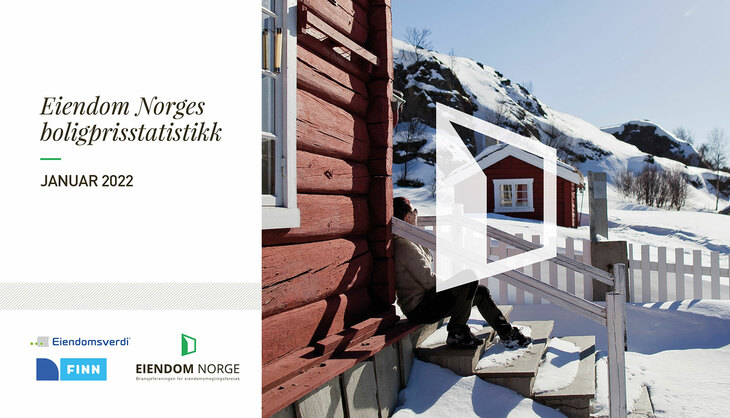
Record strong growth in housing prices in January
Housing prices rose by 4.8 per cent in January 2022. Adjusted for seasonal variations, prices rose by 2.1 per cent.
House prices have risen by 6.8 per cent in the last year.
The average price for a home in Norway was NOK 4,306,533 at the end of January.
- It is normal for house prices to rise a lot in January, known as the so-called January effect. But the rise in house prices in January this year is the strongest in the history of house price statistics, and the rise is broadly rooted throughout the country, says CEO Henning Lauridsen of Eiendom Norge.
- The strong rise must be seen in connection with the supply side of the housing market. There were few homes on the market at the beginning of the year and there is a significant decrease in the number of new homes on the market in January compared with previous years. The number of unsold homes is at a significantly lower level than in January 2017, when the housing market boiled, says Lauridsen.
- The new Disposal Act, which came into force on 1 January 2022, has created bottlenecks in the housing market across the country and led to fewer homes on the market. This is because the new condition reports take longer to make, especially in a run-in phase, and because new condition reports must be made for homes that have been for sale since 2021. In addition, some building experts have probably left the industry due to new rules and more responsibility. .
Significantly lower offers
In January, 5,416 homes were sold in Norway, which is 22.0 per cent less than in the corresponding month in 2021.
In January, 5,703 homes were put up for sale in Norway, which is 13 per cent less than in the same month in 2021.
- There is a weaker fall in the number put on the market than in the number sold. In order to strengthen the supply side, it is essential that the demand for condition reports is covered in the months ahead, as far more homes are normally put up for sale than in January.
- Those who are planning home sales this spring should also not wait until after Easter, as normally very many want to sell. There is no reason to wait to put the home up for sale, says Lauridsen.
It took an average of 41 days to sell a home in January, down from 51 days in December. Oslo had the shortest sales time with 22 days and Kristiansand had the longest sales time with 52 days.
- It is very fast to sell a home in Norway now, which is also reflected in the number of unsold that is below January 2017, Lauridsen says.
The flax necks must be reduced
Oslo had the strongest seasonally adjusted price development in January, with an increase of 2.9 per cent. Tromsø had the weakest seasonally adjusted price development with a seasonally adjusted increase of 0.8 per cent.
Bodø / m Fauske has the strongest 12-month growth with an increase of 14 per cent, followed by Tønsberg m / Færder with 10.6 per cent and Kristiansand with 10.3 per cent.
Oslo had the weakest development in the 12-month growth with an increase of 4.3 per cent, followed by Ålesund m / omegn of 5.4 per cent.
- It is a demanding situation in the housing market now. Historically, we know that there is a connection between new regulations and changes in the housing market. It is therefore essential that all players take control of the bottlenecks we have on the supply side so that we do not get a weak supply side and unnecessarily strong price growth, Lauridsen concludes.






